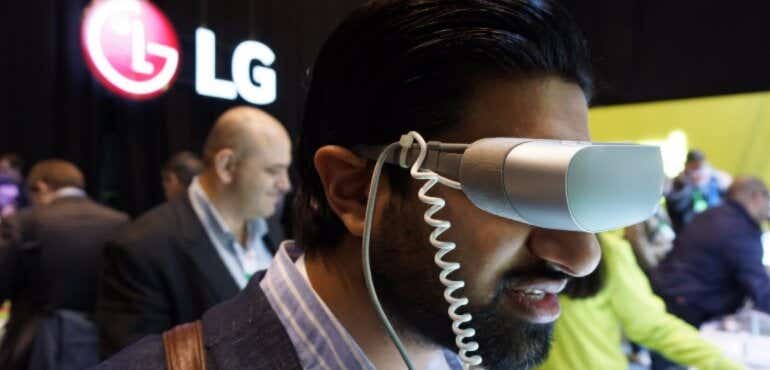Virtual reality, or VR, has been touted as the next big thing since Pierce Brosnan waded around a virtual world in the 1992 thriller 'The Lawnmower Man'.
Its graphics looked awful back then, but in the early '90s they were cutting edge. But then so were Reebok Pumps.
In the end, VR technology failed to take hold back then and it soon faded from view. But those working in laboratories all over the world didn't stop working.
Now VR is enjoying a second coming. And, crucially, the technology is much more advanced. It's a lot more affordable now, and there are a growing number of reasons to get it as the technology further develops. So the time is ripe for virtual reality to finally enter our homes and workplaces.
But what is VR? How does it work? And what options are available to you? Strap on your VR headset, and all will be explained.
What is virtual reality?
Put simply, VR is a way of creating a 3D virtual environment that you can then explore and interact with.
Most commonly, it's done by strapping on a headset that blocks out external light and shuts you off from the real world.
Screens in front of your eyes show your new environment, be it a fantasy world, a forest, outer space, whatever.
The sense of immersion and really 'being there' comes from the fact that the environment is 360-degrees. Turn your head to the side in real life and the VR screen's perspective changes too. Look behind you and it shifts again. The environment you're exploring really feels like it's all around you.
There are other major differences with VR this time around too.
As anyone who tried out earlier attempts at VR will know, previous headsets suffered from 'lag', where the environment took a while to catch up when you turned your head.
Not only did this ruin the illusion, it also made the user feel sick. But this problem has been eliminated with newer headsets.
What is it used for?
The main focus of VR so far is on games. As you can imagine, immersing players in an interactive 3D environment will make games more realistic than ever before.
Imagine a first-person shooter where you're actually running around the environment, and you can see why people are so excited.
But the uses go far beyond games.
The technology could make films and TV shows much more immersive, as well as websites, apps and pretty much anything you can do with your phone. Some offices have started to use it for hybrid meetings too.
Oculus, which is now owned by and named after Facebook's parent company Meta, was the company largely responsible for the resurgence of virtual reality. And it recently launched a digital social abd workspace called the 'Metaverse', which relies almost solely on VR technology.
More and more companies are releasing wearable cameras that record 360-degree footage too, which you can then watch back through a virtual reality headset.
This means you can capture footage of you surfing, paintballing, or just going to the shops, and watch it back in VR later, turning your head any which way to see things that you missed first time around.
Which VR headsets are available?
Meta rules the roost when it comes to VR options, but other companies aren't far behind.
There are a range of headsets at different budgets and for different needs, such as:
Oculus Quest 2
, which beginners would get on with the most
Sony Playstation VR
, a very popular headset with PS4 and PS5 players
HTC Vive Pro
, for the power users and technology whizzes
Samsung Gear VR
, if you want to roam around with a mobile headset (and own a Samsung phone)
Nintendo Labo VR Kit
, for children or people wanting a different experience with their Nintendo Switch
Which VR headsets work with smartphones?
A few years ago, there used to be a number of cheaper headsets that worked with your smartphone. You'd play a 360-degree video on yoir smartphone screen, place the phone in the headset and look around.
But this technology has largely gone out-of-fashion as proper VR headsets have become more popular and affordable.
What else do I need?
If you want a 'true' virtual reality experience, you'll need a high-end PC to plug the headset into.
To run the high-end headsets, it's recommended that you have a PC with a high-quality Nvidia or AMD video card or equivalent, Intel i5 or higher graphics card or equivalent, at least 8GB of RAM, HDMI 1.3 or higher video output, three USB 3.0 ports and one USB 2.0 port, and the latest (or almost-latest) operating system on offer from your computer manufacturer.
Wondering if your PC is up to the task? You can check with the this compatibility tool.
What about the content?
Content is king, as everyone knows. Sadly in the case of virtual reality, there's not too much of it about at the moment, aside from a few relatively unsuccessful attempts.
Companies are keen to show off demos, and some games will launch in VR. But until the prices of the headsets come down and they're more widely available, expect content to be relatively thin on the ground.
Our prediction? The really good content won't start arriving until next year.
That said, there are some pretty impressive YouTube 360-degree videos you can watch using a cheaper smartphone headset.
While they're not interactive, they do let you turn your head and look around the environment as if you were there.
Check out the video below in full screen in your web browser for a taster.
Note: not all browsers support 360-degree videos, so make sure you're using a compatible one like Google Chrome.
Now imagine that using a headset where that's all you can see. Pretty cool, eh?
How does VR differ from augmented reality?
Augmented reality is a little different. Instead of cutting you off from the real world and creating a completely virtual environment, it superimposes virtual elements onto your view of the real world (i.e. whatever is in front of you).
The best demo of this is Microsoft's HoloLens.
As you can see, this has amazing potential for gaming, as the enemies enter your real-world environment.
But it could also be used to create virtual screens on walls that only you can see, which would be very useful for working (or slacking off, if you're that way inclined).
The first HoloLens sets are being sent out to developers now, but an actual consumer release is still some way away.
Want a sneak peek at the future? Check out this demo by augmented reality firm Magic Leap.
Make no mistake, this technology is going to be huge. But it might take a price drop for that to happen.

